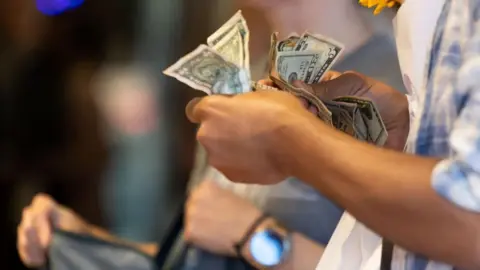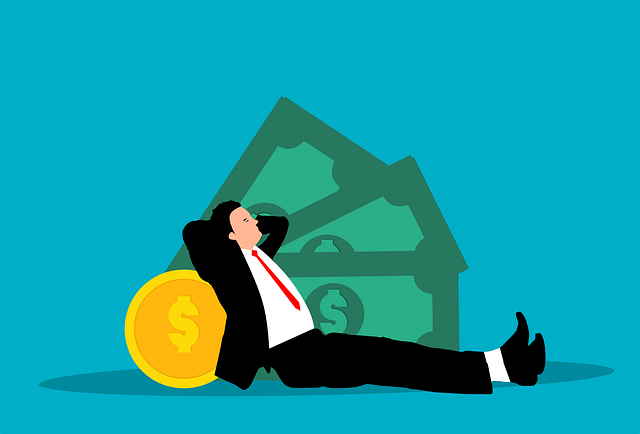 Getty Images
Getty ImagesEconomic growth picked up in the US this spring, raising hopes that the world’s largest economy will be able to get inflation under control while avoiding a painful slowdown.
The economy expanded at an annual rate of 2.8% over the three months to June, lifted by brisk consumer spending, the Commerce Department said Thursday.
The pace was faster than expected, but still marked a slowdown from 2023.
The strong figures arrive during a heated presidential campaign, in which voters have regularly named the economy as their top concern.
The country’s steady growth – far outstripping its international peers – would usually typically favour Democrats as the incumbent party.
But the current mix of conditions has made for a puzzle.
Unemployment, at 4.1%, is low but rising. Growth is solid, but has slowed from the boom that came as the economy reopened after Covid.
And though price inflation has significantly subsided, economic discontent remains elevated, as households grapple with a 20% leap in prices since 2021 and high borrowing costs.
President Joe Biden’s decision to drop out of the race has scrambled the picture further.
“There’s a lot of crosscurrents here, in terms of voters thinking about the economy,” said Mark Zandi, chief economist at Moody’s Analytics. “At this point, I don’t think it’s a headwind or a tailwind.”
Forecasters had been predicting growth this quarter of about 2%.
But Thursday’s figures showed the economy bouncing back from a slowdown at the start of the year, when gross domestic product (GDP) grew just 1.4%.
As well as strong consumer spending, the report showed increased business investment and an uptick in exports.
In a statement, Mr Biden said the report “makes clear we now have the strongest economy in the world”.
But University of Iowa professor Michael Lewis-Beck, who is known for a model that predicts popular vote outcomes based on economic growth and presidential approval, said growth did not appear to have been strong enough in the first half of this year to overcome Mr Biden’s steep unpopularity.
His model had predicted a narrow loss for Mr Biden based on the start of the year growth. He warned that Democrats would face even stiffer odds now that the president is off the ballot, as they lose any incumbent advantage.
The election remains close and complicated, he added, noting that the three elections since 1948 that his model has been wrong – in 1960, 1968 and 1976 – took place in “turbulent times”, like today’s.
“Not that the economy wasn’t relevant in those times, but there were other huge things going on,” he said, describing the current race as a “nail biter”.
Some other analysts said they thought Mr Biden’s decision to quit the race could make it easier for Democrats to pick the parts of his legacy they want to promote, while separating themselves from negatives such as inflation.
“I see upside with vice president [Kamala] Harris taking over the ticket because she can put distance between herself and President Biden” on inflation, said Danielle Deiseroth, executive director of the progressive pollster Data for Progress.
The administration’s signature economic policies – including investments in roads, bridges, advanced technology and clean energy – are otherwise popular, she noted.
“It’s an opportunity for a reset on the economic narrative,” she said.
Until Mr Biden bowed out, Mr Zandi said he had been “very uncomfortable” with the Democratic victory that his firm has been forecasting for the presidential election, using a model that takes into account things like gas prices and unemployment rates.
Now, he said he felt better “sticking with the model”.
“I think it’s a game-changer politically,” he said of Mr Biden’s move, while noting that small changes to non-economic factors such as turnout could “easily” deliver a win to Trump.
“It’s going to be very close,” he said. “It’s very much on a razor’s edge.”
What happens to the economy in the months ahead could make a difference.
Most analysts do not expect major changes to economic conditions between now and November, though some weakening is anticipated.
They are widely expecting the US central bank to cut interest rates in September, in an effort to head off further slowdown.
Those in favour of cutting soon say the Federal Reserve needs to act before borrowing costs, which stand at a roughly two-decade high, send the economy into a recession.
But the strong GDP showing could weaken that case.
For the Fed, which prizes its political independence, it is an uncomfortable position to be in, especially since a cut, which would provide relief to households with credit card debt and businesses looking to borrow, might boost Democrats, Mr Zandi said.
“What the Fed does or does not do here matters,” he said.

